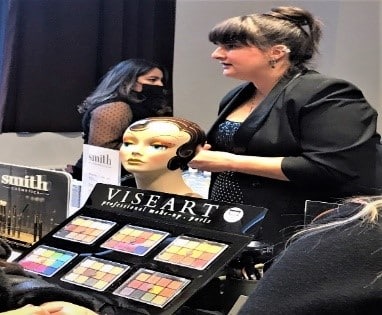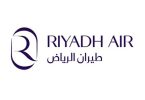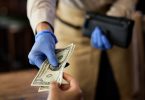When in Doubt Wear Red!
I can give witness; young, high-energy, dedicated women were crowded into New York’s Metropolitan Pavilion, pushing and shoving to get to the salespeople who were quickly stuffing their independent brands of cosmetics and skincare products into shopping bags.
It was a cold, wet, dreary day – a few weeks before Christmas. The streets were almost empty; only a few intrepid shoppers were brave enough and anxious enough, to leave the comfort of their couches to deal with the challenge of shopping for friends and family.
The tight spaces were jammed with professional makeup artists and energetic cosmetic/skincare entrepreneurs while scores of young women impatiently surrounded them for products, advice, and even a hug. If someone from another planet landed in this space, they would have believed that this was the absolute last opportunity for these young women to buy makeup.
There may be concerns with the declining spending available from 18-35 y/o female credit card holders; however, if anyone was monitoring the cash registers at the MakeUp Show vendor tables, you would quickly understand that quick purchases of eyeshadows, mascaras, and wigs, bringing broad smiles on many faces, was the result of these high-energy consumers having access to a wide range of makeup.

TABS Analytics, in their second annual US Cosmetics Study, found that millennial women (18-34) spend the most money on beauty products and are twice as likely to be heavy buyers (purchasing 10+ types of products a year) and account for 47 percent of all heavy buyers.
MakeUp = Positive Cash Flow
The cosmetics industry is one of the most valuable global markets, with the USA taking a major position in this space. The increasingly large number of people across the nation buying personal care and beauty products is amazing:
Approximately $49.2 billion is generated by cosmetics sales in the USA each year; $500 billion globally.
In 2020, North America accounted for 24% of the global cosmetics market. Current numbers place the Asia Pacific region as the largest consumer of cosmetics. Within the European cosmetic market, Germany consumed the largest number of cosmetics in 2021, valued at approximately 13 billion Euros. This was followed by France and Italy, at approximately 12 billion Euros and 10.6 billion Euros, respectively.
On average, Americans spend from $110 – $313 on cosmetics each and every MONTH.
Skincare products account for 42 percent of the cosmetics industry, representing the largest market segment.
Importance of Social Media
- In 2020, even with a global pandemic and every one confined to their own walls, the beauty, and cosmetics industry declined by a mere 8 percent.
- Approximately 61 percent of all beauty buyers followed cosmetic brands or visited a brand on social media (June 2019), making social media engagement significantly important for cosmetic brands.
- Social media is a leader in bringing cosmetic information to consumers allowing brands to establish trust with their customers and market their products appropriately.
- Estimates suggest that 37 percent of shoppers typically find new cosmetic brands/products through social media advertisements.
- 66 percent of customers discover brands on social media as a result of updates on the brand’s social media pages, along with posts from expert bloggers and celebrity endorsements.
Brand Leadership
The France-based multinational, L’Oréal, founded in 1909, is the largest beauty firm in the world with sales valued at $34 billion. In 2021, the company-controlled 20 percent of the cosmetics industry share in Western Europe. Unilever PLC, a British multinational, started in 1929, posts sales of $26 billion, and places in second place on the world stage. The company distributes products in 190 countries with 25 million global retail outlets. The company owns 50 of the top consumer brands worldwide.
Two years ago eTN asked if all cosmetics should be Halal Cosmetics.
Cosmetics. (2022, December 29). In Wikipedia.
The third place is held by the Estee Lauder Companies which is based in the US. Started in 1946, it posts sales worth $16 billion and represents more than 25 high-end skincare, makeup, fragrance, and hair care products that are sold in 150 countries under brand names that include Estee lauder, Aramis, Clinique, Lab series, Origins, Tommy Hilfiger, DKNY, MAC, la Mer, Bobbi Brown, Aveda, Jo Malone London, Smashbox, Michael Kors, Darphin Paris, Tom Ford Beauty, Ermenegildo Zegna, Serin, Bumble, and Bumble, Le Labo, Glamglow Killian Paris, Too Face, Dr. Jart, The Ordinary and NIOD.
Controlling fourth place is The Procter & Gamble Company which was founded in 1837 and records sales of $14.4 billion. Product lines include Head & Shoulders, Rejoice, Herbal Essences, Pantene, Olay, Safeguard, Old Spice, Secret, and SK-11. Shiseido, a Japanese multinational, grabbed fifth place in the global market and posted sales in excess of $9 billion. Another leading cosmetic company (and market leader since the early 20th century) has been secured by Bath & Body Works, holding sixth place. Started in 1990, this US-based multinational is a top beauty firm with sales valued at $7.9 billion.
Johnson & Johnson takes over place number 7. Founded in 1886, this US-based multinational records sales at $7.7 billion with brands that include Johnson Baby Products, Aveeno, Clean & Clear, Lubriderm, Neutrogena, Vivi, and Bloom. In eighth place is the French-based LVMH. A luxury-focused organization, it records sales worth $7.5 billion from brands that include Christian Dior, Miss Dior, J’Adore Infinissime, and Rouge Dior makeup. The company also owns Tag Heuer, Louis Vuitton, Givenchy, Tiffany & Co., Bulgari, Acqua Di Parma, and Marc Jacobs Beauty.
Wanted/Desired
In 2020, approximately $1.96 billion was made from the sale of eye cosmetics and $1.9 billion was generated from the sale of facial cosmetics. Mascara was the most profitable product in the eye cosmetic segment, followed by eyeliners, eye shadows, and eyebrow makeup. Neutrogena makeup removers were the most profitable product in the facial cosmetics segment.
Ulta Beauty is the leading health and beauty retailer in the US. In 2019 the chain beauty store generated approximately $7.4 billion in retail sales. Sephora was behind Ulta generating $5.9 billion in retail sales in the same year.
The Lip Stick Index: Economic Indicator
Originated by Estee Lauder heir, billionaire Leonard Lauder noticed how, during recessionary periods, when consumer spending usually drops, sales of his products actually increased. He reasoned that while consumers may cut back on discretionary items, they still spend money on “affordable luxuries” giving birth to the Lip Stick Index.
Lipstick is not affected by inflationary pressures and the product offers wide profit margins. A tube of lipstick is produced at an approximate cost of $2.50 and women are willing to spend upward of $35 (i.e., Christian Louboutin Velvet Matte lip color: $90 at Sephora; Bond #9 lip color: $105 at Bloomingdale’s).
The cosmetic industry does not keep pace with other sector price increases. NielsenIQ reported that while prices for consumer-packaged goods increased by 8 percent at the end of 2021, health and beauty goods increased by only 4 percent. Unlike food products or electronics, cosmetics are not as impacted by energy prices, beyond the costs associated with packaging and shipping.
The lipstick offers users something more than colorful lips.
Throughout history, women associated the application of makeup as an act of defiance and liberation. Psychoanalysts have linked brightly colored lipstick (including the bullet-shaped applicator), as a form of armor or protection against the world. In June 2022 (NPD Group report) found that lipstick sales increased by 48 percent over 2021.
The Makeup Show (TMS)
The MakeUp Show/Shop is a welcome event in New York Manhattan, as it enables fashionistas to grab their favorite makeup and hair care products in a space that is dedicated to them and their thirst for quick access to over 40 makeup and skincare brands at a professional discount and sample sale prices. An additional incentive to attend the show is the opportunity to rub shoulders with professional makeup artists including Renny Vasquez representing Pat McGrath Labs, Jake Aebly (Alcone Company) who instructs on Glitz and Glam, and Danessa Myricks, artist and brand owner.
© Dr. Elinor Garely. This copyright article, including photos, may not be reproduced without written permission from the author.























